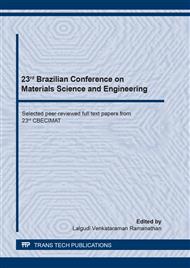p.119
p.125
p.131
p.136
p.141
p.147
p.153
p.158
p.167
Low-Temperature Reduction of Graphene Oxide Using the HDDR Process for Electrochemical Supercapacitor Applications
Abstract:
In the present work, attempts of reducing a graphene oxide powder using a low temperature hydrogenation disproportionation desorption and the recombination process (L-HDDR) has been carried out. A lower processing temperature in large scale production is significant when costs are concerned. Graphite oxide was prepared using a modified Hummers’ method dispersed in ethanol and exfoliated using ultrasonication to produce Graphene Oxide (GO). Investigations have been carried out by X-ray diffraction (XRD) and scanning electron microscopy (SEM). The experimental results of L-HDDR processing graphene oxide powder, using unmixed hydrogen at 400°C and relatively low pressures (<2 bars) have been reported. X-ray diffraction patterns showed a reduction of graphene oxide with the L-HDDR process. The results showed that both processes, the L-HDDR as well as the standard HDDR, may be applied to the reduction of graphene oxide in order to produce supercapacitor materials. The advantage of employing the L-HDDR process is a relatively low temperature reducing the cost of treatment, what is a very important factor for producing a large amount of material. Thus, the L-HDDR process has been considered a promising alternative method of reducing graphene oxide with efficiency, with the possibility of large scale production.
Info:
Periodical:
Pages:
141-146
Citation:
Online since:
October 2020
Price:
Сopyright:
© 2020 Trans Tech Publications Ltd. All Rights Reserved
Share:
Citation:


